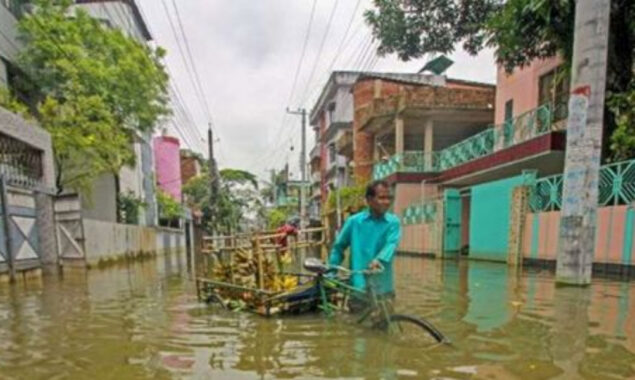
Picture: Flood outside the residence
Ronju Chowdhury described the scene outside his home on Saturday. He lives in the remote village of Udiana in the northeastern Indian state of Assam, which has been hit by a severe flood. He remembered that it was still raining.
The water blew so fast that the streets were completely flooded in a matter of hours. When the water entered their house, he said the family was sitting in the dark together to protect them.
Two days later, the family is still trapped in a house that looks like a secluded island in the middle of the sea. “We are surrounded by floods and have no drinking water. There is no food. Now we hear that the water level is rising, “said Chowdhury. “What happened to us?”
Read more: In India and Bangladesh, heavy rain, floods, and thunder have killed dozens of people.
Unprecedented rains and floods ravaged Assam, flooded villages, destroyed crops and destroyed homes. Authorities said last week that 32 of the 35 provinces had been affected, with at least 45 deaths and more than 4.7 million displaced. Last week’s heavy rains also killed 18 people in neighboring Meghalaya. The government has opened 1,425 refugee camps for refugees in Assam, but authorities say the severity of the disaster has disrupted operations. Even the rescue team is in poor condition.
“There is no drinking water in the camp. My son has a fever and I can’t take him to the hospital “, said Husna Begum from Udian. When the water reached his home on Wednesday, a 28-year-old man crossed a stream in search of help. . She and her two children are now hiding in a plastic tent.
“I have never seen anything like it before. “I’ve never seen such a big flood in my entire life.”
The floods have repeatedly affected the lives and livelihoods of millions of people living near the fertile banks of the mighty Brahmaputra River, often referred to as the Assam lifeline. However, experts say that factors such as climate change, uncontrolled construction and rapid industrialization have increased the incidence of extreme weather events.
Read more: Heavy rainfalls may trigger landsliding, generate flash flooding: Met Office
This is the second flood in Assam this year, killing at least 39 people in May. According to the Meteorological Administration, this state received 109% more precipitation than the average this month. And in many places it crosses a red flag called Brahmaput. In an interview with the BBC, residents and authorities described the recent floods as one of “biblical proportions” that has changed the country’s social and economic structure.
“It simply came to our notice then. Rangiya unit officer Javir Rahul Suresh told the National Emergency Response Team (NDRF) that he had deployed troops to support rescue operations.
“Our main priority right now is to save lives.”
All the settlements flooded overnight like a big river. In Guwahati, Assam’s main economic center, the land has been reclaimed. Previously, rice fields and rice fields were transformed into large swamps of mud and gravel. There are no schools, hospitals, temples or mosques in Udiana, only water. People travel in boats made of banana leaves and bamboo sticks. The rest, unfortunately, swim in brown, green, and fresh water, and your eyes are open to see the rescuers from afar in bright orange robes.
Victims are particularly concerned about the Kamrup region, a rural area where hundreds of people are being held in their homes. Siraj Ali, 64, said his life was in danger when floods flooded the village. But now in a partially flooded house, he remains to preserve his fortune and “memory of life.” She said she sent the children to shelters on the side of the road while she waited for help. But no one has reached that point yet. “I am surrounded by water, but I have no drinking water and nothing to eat. I’m hungry for the third day. What should I do, where should I go? he asks with tears. Mr Ali is now finding relief in the company of his full-time neighbor, Mohammad Rubul Ali. This friend decided to stay behind to protect his house, the little hut he had worked so hard on.
“Every purchase – a bicycle, a bed, a chair – was an important milestone for me. But now there is nothing left. The flood took everything away from me “, said Rubel. Authorities acknowledged that they could not provide drinking water and food to all flood victims.
“It is still difficult to reach some areas that are completely blocked. The road to it was completely destroyed in the water, “Suresh said.
Experts say climate change is hampering the state’s long-term efforts to better respond to floods, but several other factors are at stake. Jayashri Rout, a professor of ecology at Assam University, said: “There is no doubt that the floods are very severe this time and the frequency of the rains is increasing significantly.” “But before it can be fully linked to climate change, we need to consider human factors such as deforestation.”
According to Professor Rout, we need to stop cutting down big trees, especially near rivers. This is because the roots of this tree can hold water. But people like Chowdhury don’t have time to think about why.
On Saturday, as the sun shone and the cloudy sky over Udiana’s cloudy horizon, he stood in front of his half-sunken house. “So far no one was able to send in the perfect solution, which is not strange.” – Is anyone coming?
Read More News On
Catch all the International News, World News, Breaking News Event and Latest News Updates on The BOL News
Download The BOL News App to get the Daily News Update & Follow us on Google News.




